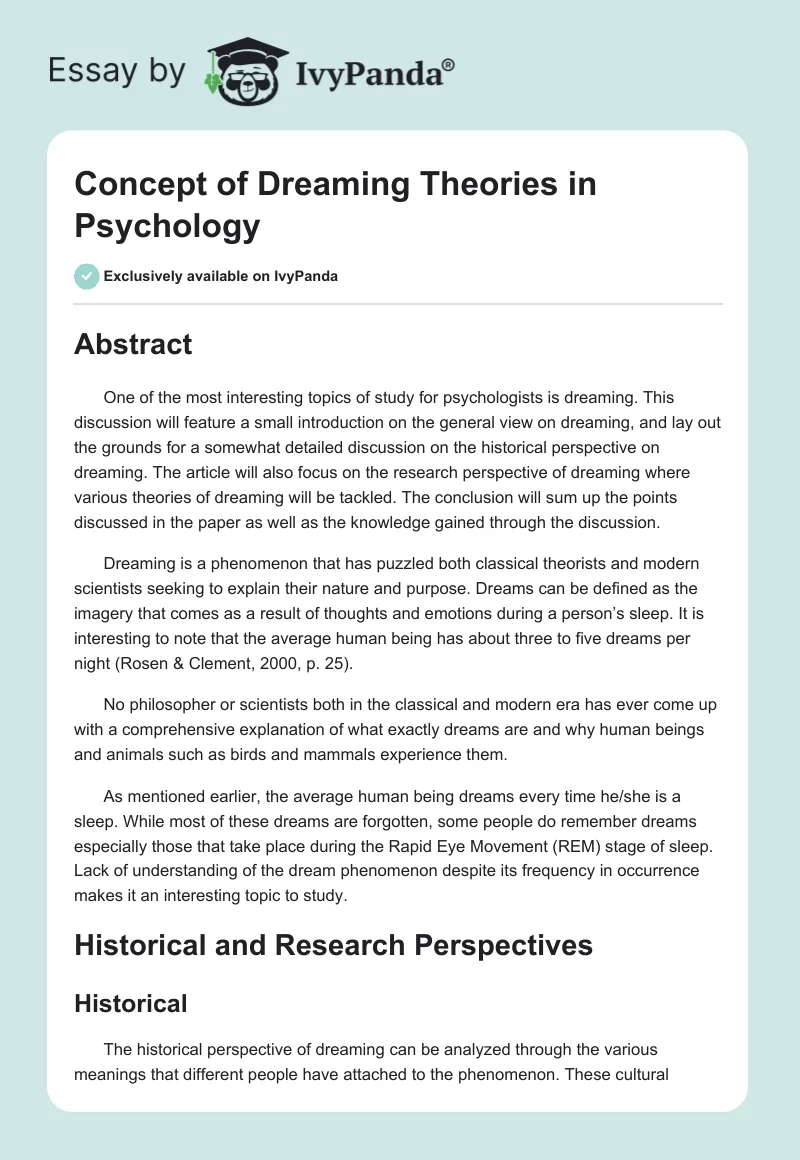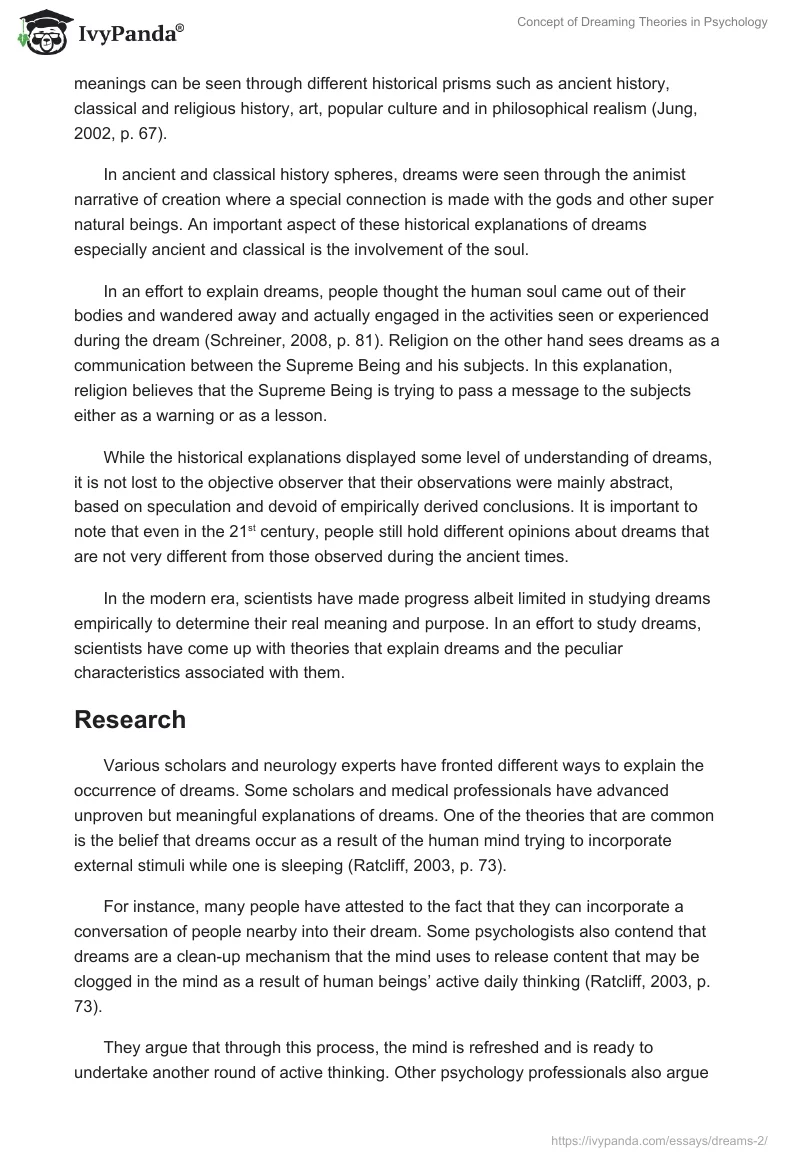Abstract
One of the most interesting topics of study for psychologists is dreaming. This discussion will feature a small introduction on the general view on dreaming, and lay out the grounds for a somewhat detailed discussion on the historical perspective on dreaming. The article will also focus on the research perspective of dreaming where various theories of dreaming will be tackled. The conclusion will sum up the points discussed in the paper as well as the knowledge gained through the discussion.
Dreaming is a phenomenon that has puzzled both classical theorists and modern scientists seeking to explain their nature and purpose. Dreams can be defined as the imagery that comes as a result of thoughts and emotions during a person’s sleep. It is interesting to note that the average human being has about three to five dreams per night (Rosen & Clement, 2000, p. 25).
No philosopher or scientists both in the classical and modern era has ever come up with a comprehensive explanation of what exactly dreams are and why human beings and animals such as birds and mammals experience them.
As mentioned earlier, the average human being dreams every time he/she is a sleep. While most of these dreams are forgotten, some people do remember dreams especially those that take place during the Rapid Eye Movement (REM) stage of sleep. Lack of understanding of the dream phenomenon despite its frequency in occurrence makes it an interesting topic to study.
Historical and Research Perspectives
Historical
The historical perspective of dreaming can be analyzed through the various meanings that different people have attached to the phenomenon. These cultural meanings can be seen through different historical prisms such as ancient history, classical and religious history, art, popular culture and in philosophical realism (Jung, 2002, p. 67).
In ancient and classical history spheres, dreams were seen through the animist narrative of creation where a special connection is made with the gods and other super natural beings. An important aspect of these historical explanations of dreams especially ancient and classical is the involvement of the soul.
In an effort to explain dreams, people thought the human soul came out of their bodies and wandered away and actually engaged in the activities seen or experienced during the dream (Schreiner, 2008, p. 81). Religion on the other hand sees dreams as a communication between the Supreme Being and his subjects. In this explanation, religion believes that the Supreme Being is trying to pass a message to the subjects either as a warning or as a lesson.
While the historical explanations displayed some level of understanding of dreams, it is not lost to the objective observer that their observations were mainly abstract, based on speculation and devoid of empirically derived conclusions. It is important to note that even in the 21st century, people still hold different opinions about dreams that are not very different from those observed during the ancient times.
In the modern era, scientists have made progress albeit limited in studying dreams empirically to determine their real meaning and purpose. In an effort to study dreams, scientists have come up with theories that explain dreams and the peculiar characteristics associated with them.
Research
Various scholars and neurology experts have fronted different ways to explain the occurrence of dreams. Some scholars and medical professionals have advanced unproven but meaningful explanations of dreams. One of the theories that are common is the belief that dreams occur as a result of the human mind trying to incorporate external stimuli while one is sleeping (Ratcliff, 2003, p. 73).
For instance, many people have attested to the fact that they can incorporate a conversation of people nearby into their dream. Some psychologists also contend that dreams are a clean-up mechanism that the mind uses to release content that may be clogged in the mind as a result of human beings’ active daily thinking (Ratcliff, 2003, p. 73).
They argue that through this process, the mind is refreshed and is ready to undertake another round of active thinking. Other psychology professionals also argue that dreaming is a natural therapeutic function that the brain undertakes to help human beings connect between the various pieces of information that may be stored in the mind (Blass, 2002, p. 41).
The above theories only represent the general view of many of the professionals involved with sleep disorders in human beings. One of the most compressive and outstanding dream theories however is the psychoanalytic theory of dreaming mainly fronted by Sigmund Freud. According to Freud, dreams are a reflection people’s desires and aspirations (Flanagan & Cardwell, 2003, p. 55).
Freud’s larger theory fronts a controversial view that every human being’s personality is driven by aggressive sexually inclined desires that people try to repress from their conscious awareness. Freud’s psychoanalytic theory further suggests that despite human beings’ suppression of these aggressive sexual instincts and desires, these feelings somehow make their way to our conscious awareness through dreams (Flanagan & Cardwell, 2003, p. 56).
Freud’s theoretical explanation may be used to explain for instance how and why sometimes people dream about the events that they know are going to occur. It is important to note that these feelings may necessarily not be sexual in nature, only that Freud’s theory assumes that every human action is driven by a sexual drive.
To further explain the occurrence and purpose of dreams, Freud introduced two other concepts i.e. manifest and latent content (Flanagan & Cardwell, 2003, p. 58). Manifest content is the actual imagery that is present during a dream while latent content is the meaning behind the imagery.
Besides, Freud’s psychoanalytic theory of dreaming, J. Allan Hobson and Robert McClarley also advanced the Activation – Synthesis Model of dreaming. Unlike the Freud theory, this theory seeks to give a scientific explanation of dreaming. An important premise of this theory is the assumption that the brain itself is the genesis of dreaming through the release of various internal signals. According to this theory, the brain’s circuits get active during the REM stage of sleep effectively activating its cognitive functions (Blass, 2002, p. 63).
The limbic system of the brain which is involved with the above functions then interprets the signals effectively resulting in dreaming. One of the shortcomings of this theory is its failure to explain how and why the brain releases the internal signals. It cannot be used to explain why for instance someone dreams about an event that is likely to occur in the future. Also, it does not explicitly acknowledge that the events in the environment are a major contributor to the dreaming process.
Conclusion
There is no doubt that human beings are still miles away from understanding the dream phenomenon. From the above information, it is clear that every human being dreams and, dreaming is involuntary. Though there is no consensus on the real meaning behind dreaming, there is some agreement among scholars and medical professionals that dreams have a major connection between the events that one goes through and the cognitive engagement that is involved.
References
Blass, R. (2002). The Meaning of the Dream in Psychoanalysis. Berlin: Springer.
Flanagan, C. & Cardwell, M. (2003). Psychology A2: The Complete Companion. New York: Rodwell Press.
Jung, C. (2002). Dreams. London: Sage Publications.
Ratcliff, A. (2003). History of Dreams. London: Sage Publications.
Rosen, T. & Clement, S. (2000). Dreams: Working Interactive. New York: Routledge.
Schreiner, O. (2008). Dreams. Cambridge: Cambridge University Press.


